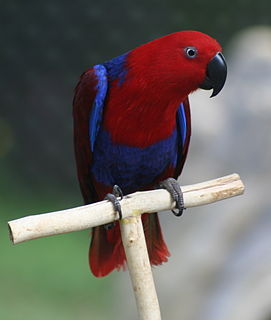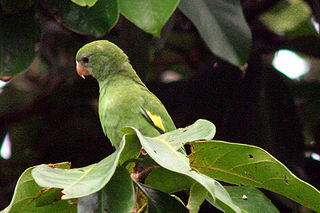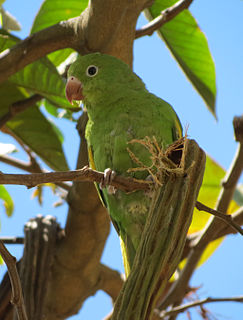
A parakeet is any one of many small to medium-sized species of parrot, in multiple genera, that generally have long tail feathers. Older spellings still sometimes encountered are paroquet or paraquet.
The Sibley-Monroe checklist was a landmark document in the study of birds. It drew on extensive DNA-DNA hybridisation studies to reassess the relationships between modern birds.

Conures are a diverse, loosely defined group of small to medium-sized parrots. They belong to several genera within a long-tailed group of the New World parrot subfamily Arinae. The term "conure" is used primarily in bird keeping, though it has appeared in some scientific journals. The American Ornithologists' Union uses the generic term parakeet for all species elsewhere called conure, though Joseph Forshaw, a prominent Australian ornithologist, uses conure.

Psittaculini is a tribe of parrots of the family Psittaculidae. The subdivisions within the tribe are controversial.

The neotropical parrots or New World parrots comprise about 150 species in 32 genera found throughout South and Central America, Mexico, and the Caribbean islands, and two species formerly inhabited North America. They are also present on a few Pacific islands such as the Galápagos. Among them are some of the most familiar and iconic parrots, including the blue and gold macaw, sun conure, and yellow-headed amazon.

The white-winged parakeet, also called the canary-winged parakeet, is a small parrot native to the Amazon River basin from southeast Colombia to the River's mouth in Brazil. Caged birds have been released and the birds have established self-sustaining populations in Lima, Peru, the Los Angeles, San Francisco, California and Miami, Florida areas of the United States, and in Puerto Rico. Although feral birds are showing some recent declines as nesters in the United States, they seem to be doing well in their native habitat.

The yellow-chevroned parakeet, is native to tropical South America south of the Amazon River basin from central Brazil to southern Bolivia, Paraguay and northern Argentina. Caged birds have been released in some areas and the birds have established self-sustaining populations in the Los Angeles, San Francisco, California and Miami, Florida areas of the United States. This bird seems to be doing better in its North American feral population than its closely related cousin, the white-winged parakeet. The species is also fairily established in the downtown area of Rio de Janeiro, Brazil, where it was introduced. The native population in South America continues to do well.

Pyrrhura is a genus of parrots in the Arini tribe. They occur in tropical and subtropical South America and southern Central America. Most are restricted to humid forest and adjacent habitats, but one species, the blaze-winged parakeet, prefers deciduous or gallery woodland, and another, the Pfrimer's parakeet, is restricted to dry regions. Some species are highly endangered.

A feral parrot is a parrot that has adapted to life in an ecosystem to which it is not native. Many are descended from pets that have escaped or been deliberately released. Feral parrots may affect native biodiversity, human economy and wellness.

The Caatinga parakeet or cactus parakeet is a species of parrot in the family Psittacidae. It is endemic to the Caatinga region in north-eastern Brazil.

The golden-winged parakeet is a species of bird in the family Psittacidae, the true parrots.

Brotogeris is a genus of small parrots endemic to Central and South America. The closest relative is the monk parakeet. They eat seeds and fruit.

The cobalt-winged parakeet is a species of bird in the family Psittacidae, the true parrots. It is found in the eastern Andean foothills, the far western Amazonian regions in Venezuela, Colombia, Ecuador, Peru, and Bolivia; in Brazil, the Amazon Basin states of Amazonas, Acre, and Rondonia. Its natural habitats are subtropical or tropical moist lowland forests and heavily degraded former forest.

The orange-chinned parakeet, also known as the Tovi parakeet, is a small mainly green parrot of the genus Brotogeris. It is found in Colombia, Costa Rica, El Salvador, Guatemala, Honduras, Mexico, Nicaragua, Panama, and Venezuela. Its natural habitats are subtropical or tropical dry forests, subtropical or tropical moist lowland forests, and heavily degraded former forest. Its name comes from a small clump of bright orange feathers located under the lower beak. Like other parrots, it is capable of imitating simple human speech.

The grey-cheeked parakeet, less commonly known as fire-winged parakeet, is a species of parrot in the family Psittacidae.

The tui parakeet is a species of bird in the family Psittacidae, the true parrots. It is found in the Amazon Basin of Brazil, and Amazonian Peru and Bolivia; also a minor range into eastern Ecuador, and the river border of far south-eastern Colombia.

The plain parakeet is a species of parrot in the family Psittacidae. It is endemic to Brazil.

Arenillas Ecological Reserve is a 17,083-hectare (42,210-acre) protected area in Ecuador situated in the El Oro Province, in the Arenillas Canton and in the Huaquillas Canton.

The Arapixi Extractive Reserve is an extractive reserve in the state of Amazonas, Brazil.
















